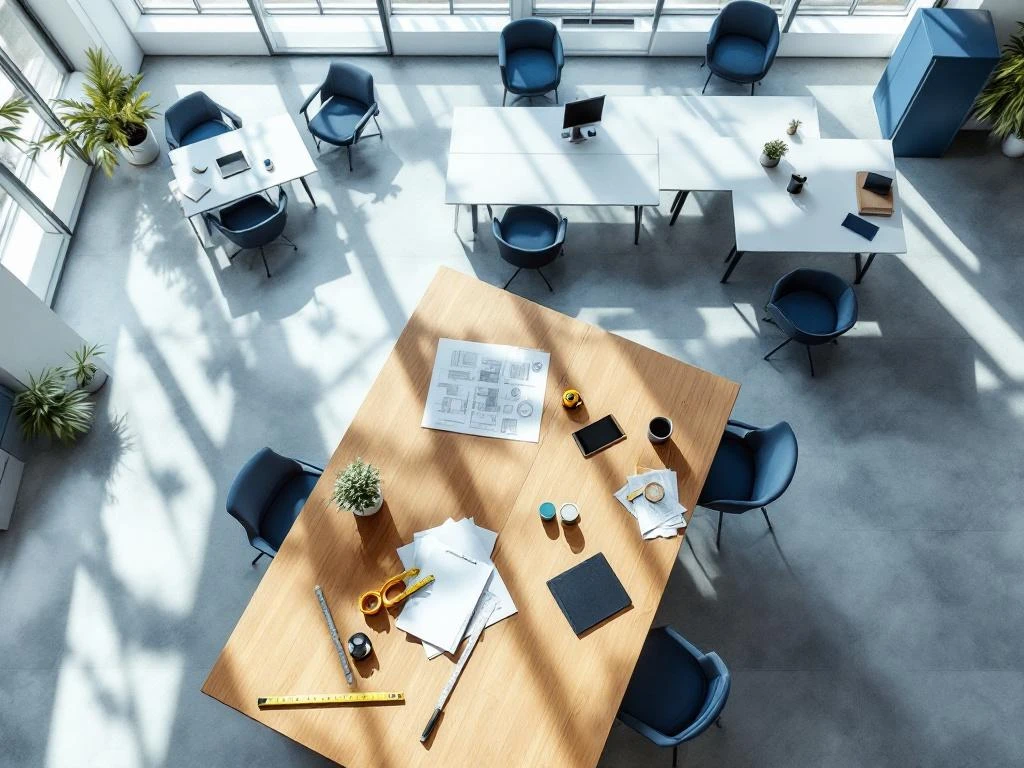An office should be at least 8 to 10 square meters per person according to Dutch guidelines, with the total space also taking into account aisles, common areas and facilities. For a comfortable work environment, experts often recommend 10 to 12 square meters per employee, depending on the type of work and desired layout. When determining the right office size, factors such as operations, number of employees, legal requirements and future growth play an important role.
What are the minimum dimensions for an office space?
The minimum dimensions for an office space start at 8 square meters per workstation according to Dutch guidelines, but for a comfortable work environment, 10 to 12 square meters per person is recommended. This size includes not only the workstation itself, but also the required movement space around the desk.
Aisles should be at least 90 centimeters wide for normal passage, while main corridors where people can pass each other should be at least 120 centimeters wide. The space behind a desk should be at least 100 centimeters so you can get up and move around comfortably without running into walls or other obstacles.
For a standard workstation with desk and chair, you need an area of about 160 by 80 centimeters for the desk itself, plus enough space around it. This means that an individual workstation including movement space will quickly take up 6 to 8 square meters, not counting closet space, printers or other office supplies.
How many square feet do you need per person in an office?
The recommended square footage per person ranges from 8 to 12 square feet, depending on the type of work and office setup. For administrative work where employees work primarily at a computer, 8 to 10 square feet per person is often sufficient.
For creative positions or work that requires more space, such as architects or designers working with large drawings, 12 to 15 square feet per person is more realistic. These professionals often need additional space for drawing tables, material samples or presentation facilities.
In an open office landscape, you can use space more efficiently and often end up with 8 to 10 square meters per person. In cubicle offices with individual rooms, you quickly need 12 to 14 square meters per person because of the extra walls and corridor space. Flexible workstations where not everyone is present at the same time can further reduce the space needed per employee to about 6 to 8 square meters.
What does the Occupational Health and Safety Act say about office size?
The Occupational Health and Safety Act imposes specific requirements on office spaces to ensure a safe and healthy work environment guarantee. According to the law, every workplace must be at least 2 meters high, with a free floor area of at least 1.5 square meters per person in the immediate work environment.
Ventilation is an important part of the Occupational Health and Safety Act requirements. A minimum of 30 cubic meters of fresh air per person per hour must be provided. This means that with a standard ceiling height of 2.6 meters, you must allow for sufficient space to ensure this air quality.
The law also requires that employees have adequate room to move. This means that desks must be placed so that employees can get up, move around and leave the building quickly in an emergency. Escape routes must always remain clear and be at least 80 centimeters wide.
How do you calculate the office space needed for your team?
To calculate total office space, start with the number of employees multiplied by the square footage per person. For a team of 10 people with 10 square feet per person, you end up with 100 square feet of workstations.
Then add the common areas:
- Meeting rooms: count 15-20% of your total workspace area
- Kitchen/pantry: about 15-20 square meters for teams of up to 20 people
- Toilets: at least 1 toilet per 15 employees
- Reception area: 10-15 square meters
- Storage area: 5-10% of total area
Also consider future growth. If you expect to grow 20% within two years, include this additional space directly in your calculation. For flexible growth, you can also consider office space for rent with potential for expansion, so you can grow with them without having to move immediately.
What factors determine the ideal office size?
The type of work is the most important factor in determining the ideal office size. Companies in the creative sector often need more space for brainstorming sessions and project work, while administrative functions can work more efficiently in more compact spaces.
The number of employees and their attendance also plays a big role. In hybrid working where employees alternate between home and office, you can assume a utilization rate of 60-70%. This means that you don't have to reserve a permanent workstation for each employee.
Other important factors are:
- Required technical facilities such as server rooms or printing facilities
- Reception facilities for customers and visitors
- Balance between open workstations and quiet zones for concentrated work
- Storage needs for documents, supplies or products
- Parking and accessibility of the location
What is the difference between gross and net office area?
Gross floor area (GFA) includes the total area of an office space, including all walls, structures, shafts and common areas such as corridors, restrooms and technical rooms. This is the measure often used in leases and real estate ads.
Net floor area (NVO) is the actual usable space for workstations and office-specific functions. The difference between GFA and NVO can be as much as 15-25%, depending on the building type and layout.
As a practical example, for an office with 1000 sq. ft. of GLA, you can assume about 750-850 sq. ft. of NVO. This ratio is important when planning your office layout. If you need 10 square meters per employee, base this on the NVO, not the UPO. So for a team of 50 people, you need 500 m² NVO, which equates to about 600-650 m² GFA.
What should be the minimum size of a home office?
An effective home office needs a minimum of 4 to 6 square meters, but 8 to 10 square meters offers more comfort and functionality. The minimum space should accommodate a 120 x 60 centimeter desk, a good office chair and enough room to move around.
For an optimal home office, keep these dimensions in mind:
- Desk: 120-160 cm wide, 60-80 cm deep
- Space behind desk: at least 90 cm for chair movement
- Side space: at least 60 cm on one side for standing up
- Storage space: cabinet or shelves 40-60 cm deep
With limited space, you can be smart about the available square footage by using wall shelves for storage, choosing a collapsible or height-adjustable desk, or installing a corner desk that makes the best use of the space. Always ensure good lighting and ventilation, though, even in a compact home office.
Which office layout fits which room size?
Open plan offices are the most space-efficient, requiring 6-8 sq. ft. per person. This layout works well for teams that work together a lot and is ideal for spaces as small as 100 sq. ft. The downside is the lack of privacy and possible noise pollution.
Cellular offices with individual rooms require 12-15 sq. ft. per person because of the additional walls and corridors. This arrangement suits organizations where privacy and concentration are important, but requires a minimum of 200-300 sq. ft. for an effective layout.
Combi-offices combine open workstations with some enclosed spaces and require an average of 10-12 sq. ft. per person. Activity-based working, where employees choose from different workstations depending on their task, can do with 7-9 sq. ft. per person when you assume a flexible staffing. This modern approach works great in medium to large spaces from 150 sq. ft. and up.
How can you optimize a small office?
In a small office, make the most of height by installing wall systems and tall cabinets. Choose multifunctional furniture such as desks with built-in storage or folding tables that you can use as conference tables when needed.
Create flexible workstations by using height-adjustable desks that serve as both sitting and standing workstations. Use movable partitions to create temporary private spaces without installing permanent walls. This allows you to adapt the space to different work needs.
Practical tips for small offices:
- Use light colors and mirrors to make the room appear larger
- Choose wireless equipment to minimize cables
- Place workstations near windows for natural light
- Use space under stairs for storage or as workspace
- Invest in good lighting to avoid dark corners
Key considerations in determining office size
When determining the right office size, future-proofing is an important consideration. Don't just plan for your current team; think about where your company will be in two to three years. A flexible office solution where you can scale up or down will save you time and moving costs.
Employee well-being should be at the center of your considerations. Ample space, natural light and good ventilation contribute to productivity and satisfaction. Overly cramped offices lead to stress and reduced performance, while oversized spaces are unnecessarily expensive and can create an empty, unsociable atmosphere.
The balance between cost and quality is always a trade-off. Flexible office solutions like the ones we offer allow you to use professional spaces without long-term commitments. This is especially valuable for growing companies or organizations that cannot yet accurately assess their space needs. Whether you're a startup taking its first steps or an established company looking to expand, the right office size will contribute to your success. Want to learn more about options for your situation? Then take contact with us for personalized advice.

